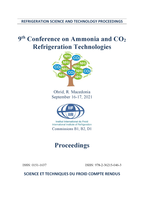
Document IIF
Recherche de fluides actifs viables sur le long terme pour les pompes à chaleur haute température allant jusqu’à 250 °C (Partie II).
Screening of future-proof working fluids for industrial high-temperature heat pumps up to 250 °C (part II).
Numéro : 0008
Auteurs : PACHAI A. C., NORMANN J., ARPAGAUS C., HAFNER A.
Résumé
With the new European Green Deal, the EU commission has committed to making Europe the world’s first climate-neutral continent. This also involves reduction of fossil fuel consumption in furnaces and boilers for the production of for example steam in industrial applications. The CO2 emissions are to be reduced by 50% going to 55% by 2030. If this challenge is to be mastered, one of the solutions will be to increase the use of electrically driven heat pumps wherever possible. If industry wants to phase out fossil steam boilers, heat pumps will have to produce steam at a temperature of about 160 °C or higher, as this is a kind of standard in current steam systems. Even 250 °C is used in some drying processes where dry saturated steam is needed because it is hygroscopic. In addition, many district heating systems in Europe still operate at 120 °C, although new systems with lower supply temperatures are becoming a new standard. Overall, this situation has sparked interest in industrial high-temperature heat pumps (HTHPs). Very often, screening for possible new refrigerants or working fluids to be used in HTHPs does not provide the full picture, especially when considering the selection of everyday parameters such as valves, compressors and oil. Therefore, this paper uses NIST's software called Cycle_D (Version 6.0), which contains the latest refrigerant data from REFPROP (Version 10.0). For comparison, the Cycle_D_HX software has too many limitations to run the simulations for HTHPs. In this study, only the refrigerant cycle is considered, although much can be done to improve efficiency by optimizing the secondary side of the system. HTHPs with condensing temperatures above 90 °C and up to 250 °C are simulated in Cycle_D. The results show that there is no universal low-GWP refrigerant suitable for all applications up to about 230 °C. However, the hydrocarbons butane (R600), iso-butane (R600a), pentane (R601) and heptane (R603) are good environmentally friendly solutions. For temperatures above 230 to 250 °C, steam (R718) is probably the only option.
Documents disponibles
Format PDF
Pages : 8
Disponible
Prix public
20 €
Prix membre*
Gratuit
* meilleur tarif applicable selon le type d'adhésion (voir le détail des avantages des adhésions individuelles et collectives)
Détails
- Titre original : Screening of future-proof working fluids for industrial high-temperature heat pumps up to 250 °C (part II).
- Identifiant de la fiche : 30028945
- Langues : Anglais
- Source : 9th IIR Conference on Ammonia and CO2 Refrigeration Technologies. Proceedings: Ohrid, North Macedonia, 16-17 September, 2021
- Date d'édition : 16/09/2021
- DOI : http://dx.doi.org/10.18462/iir.nh3-co2.2021.0008
Liens
Voir d'autres communications du même compte rendu (31)
Voir le compte rendu de la conférence
Indexation
-
Thèmes :
Pompes à chaleur à usage industriel;
HFO et HCFO;
Hydrocarbures;
Eau - Mots-clés : Pompe à chaleur; Application industrielle; Haute température; R600; R600a; R718; HFO; HCFO; Hydrocarbure; Synthèse
-
Screening of future-proof working fluids for in...
- Auteurs : PACHAI A. C., NORMANN J., ARPAGAUS C., HAFNER A.
- Date : 16/09/2021
- Langues : Anglais
- Source : 9th IIR Conference on Ammonia and CO2 Refrigeration Technologies. Proceedings: Ohrid, North Macedonia, 16-17 September, 2021
- Formats : PDF
Voir la fiche
-
Natural refrigerants versus synthetic refrigera...
- Auteurs : VIEREN E., DEMEESTER T., BEYNE W., ABEDINI H., ARTECONI A., PAEPE M. de, LECOMPTE S.
- Date : 13/06/2022
- Langues : Anglais
- Source : 15th IIR-Gustav Lorentzen Conference on Natural Refrigerants (GL2022). Proceedings. Trondheim, Norway, June 13-15th 2022.
- Formats : PDF
Voir la fiche
-
How high is high: what temperatures can we achi...
- Auteurs : HEWITT N. J.
- Date : 17/07/2024
- Langues : Anglais
- Source : 2024 Purdue Conferences. 20th International Refrigeration and Air-Conditioning Conference at Purdue.
- Formats : PDF
Voir la fiche
-
High temperature heat pump using HFO and HCFO r...
- Auteurs : ARPAGAUS C., KUSTER R., PRINZING M., et al.
- Date : 24/08/2019
- Langues : Anglais
- Source : Proceedings of the 25th IIR International Congress of Refrigeration: Montréal , Canada, August 24-30, 2019.
- Formats : PDF
Voir la fiche
-
Experimental comparison of R1224yd(Z) and R1233...
- Auteurs : ARPAGAUS C., BERTSCH S.
- Date : 31/08/2021
- Langues : Anglais
- Source : 13th IEA Heat Pump Conference 2021: Heat Pumps – Mission for the Green World. Conference proceedings [full papers]
- Formats : PDF
Voir la fiche
